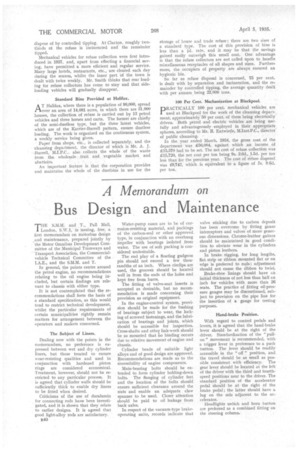A Memorandum on
Page 58

If you've noticed an error in this article please click here to report it so we can fix it.
Bus Design and Maintenance
THE S.M.M. and T., Pall Mall, London, S.W.1, is issuing, free, •a first memorandum on motorbus design and maintenance, prepared jointly by the Motor Omnibus Development Committee of the Municipal Tramways and Transport Association, the Commercialvehicle Technical Committee of the I.A.E., and the S.M.M. and T.
In general, the points centre around the petrol engine, no recommendations relating to the oil engine being included, but certain findings are relevant to chassis with either type.
It is not contemplated that the recommendations shall form the basis of a standard specification, as this would tend to restrict technical development, whilst the particular requirements of certain municipalities rightly remain matters for arrangement between the operators and makers concerned.
The Subject of Liners.
Dealing now with the points in the memorandum, no preference is expressed between wet and dry cylinder liners, but those treated to ensure wear-resisting qualities and used in conjunction with hardened piston rings are considered economical. Treatment, however, should not be restricted to any particular process. It is agreed that cylinder walls should be sufficiently thick to enable dry liners to be fitted when desired.
Criticisms of the use of duralumin for connecting rods have been investigated, and it is shown that they relate to earlier designs. It is agreed that good light-alloy rods are satisfactory.
840 Water-pump cases are to be of corrosion-resisting material, and packings of the carbon-seal or other approved type, in conjunction with an overhung impeller with bearings isolated from water. The use of soft packing is considered undesirable.
The end play of a floating gudgeon pin should not exceed a few thou sandths of an inch. Where circlips are used, the grooveS should be located well in from the ends of the holes and kept free from burrs.
The fitting of valve-seat inserts is accepted as desirable, but no recommendation is -made concerning their provision as original equipment In the engine-control system, provision should be made for the bushing of bearings subject to wear, the lock ing of screwed fastenings, and the lubrication of bearings and joints, which should be accessible for inspection. Cross-shafts and other link-work should be so mounted that o binding occurs due to relative Movement of engine and chassis.
Cylinder heads of suitable light alloys and of good design are approved. Recommendations are made as to the accessibility of engine components.
Main-hearing bolts should be extended to form cylinder holding-down bolts. The flanging of cylinder feet and the location of the bolts should ensure sufficient clearance around the nuts and enable an adequate claw spanner to be used. Closer attention should be paid to oil leakage from back axles.
In respect of the vacuum-type brakeoperating units, records indicate that valve sticking due to carbon deposit has been overcome by fitting gauze interceptors and valves of more generous dimensions. Chrome-leather gaiters should be maintained in good condition to obviate wear in the cylinders and piston leathers.
In brake rigging, for long lengths, flat strip or ribbon mounted flat or on edge is preferred to rods; adjustment should not cause the ribbon to twist.
Brake-shoe linings should have an initial thickness of not less than half an inch for vehicles with more than 26 seats. The practice of fitting oil-pressure gauges may be discontinued, subject to provision on the pipe line for the insertion of a gauge for testing purposes.
Hancbbrake Position.
With regard to control pedals and levers, it is agreed that the hand-brake lever should be at the right of the driver. Standardization of the " pullon " movement is recommended, with a trigger lever in preference to a push button. The lever should be readily accessible in the " off " position, and the travel should be as small as possible consistent with efficiency. The gear lever should be located at the left of the driver with the third and fourthspeed positions near to the driver. The standard position of the accelerator pedal should be at the right of the brake pedal ; the latter should have a lug on the side adjacent to the accelerator.
Headlights switch and horn button are preferred as a combined fitting on the steering column.




































































































